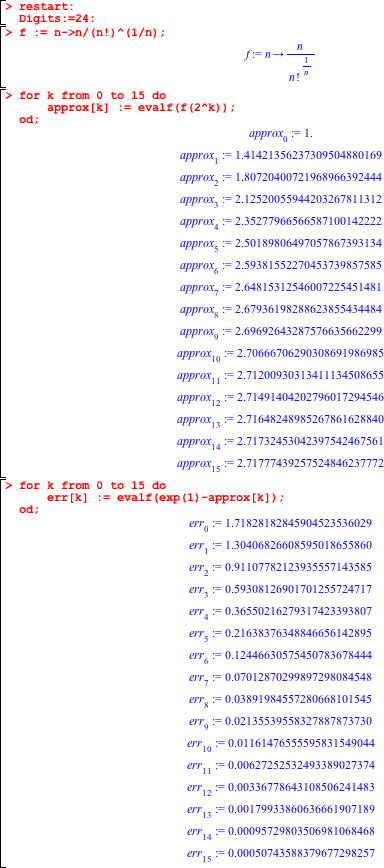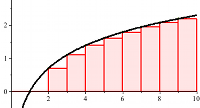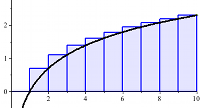This semester, I am assisting my advisor with his honors calculus class. As he is out of town today, I will be giving the lecture. We decided to show off a rather beautiful little bit of mathematics which makes use of many of the tools that we have developed since September, including an interesting application of Riemann sums. We are going to be trying to evaluate \(\newcommand{\8}{\infty}\lim_{n\to\8} \frac{n}{(n!)^{1/n}}\).
A priori, it is difficult to see that this limit converges, and is not infinite. In order to build some intuition, we start by running a little numerical experiment using Maple—a standard mathematics package. Our experiment is summarized by the following image:

If you have access to Maple, I have also provided a Maple Input File (.mpl) that you can play around with.
From our experiment, it appears that as \(n\) gets larger, the expression \(\frac{n}{(n!)^{1/n}}\) gets closer to the numerical constant \(e\).1My favorite number, by the way. It looks like the limit converges and, more specifically, that it converges to \(e\). However, a computation is not a proof, so now we need to figure out how we are going to prove the proposition.
Proposition: \(\displaystyle\lim_{n\to\8} \frac{n}{(n!)^{1/n}} = e\)
A lot of the steps required to prove this fact are a bit non-obvious. In the following, I will present the raw mathematics on the left, an try to provide some helpful roadsigns in the way of commentary on the right.
Proof: Note that \begin{aligned}
\log(n!) &= \log(1)+\log(2)+\cdots+\log(n)\\
&= \sum_{k=1}^{n} \log(k).
\end{aligned}
This is a property of logarithms. In general, if \(a\) and \(b\) are positive numbers, then \(\log(ab) = \log(a)+\log(b)\). There are no logarithms in the original problem, but working with logarithms allows us to take the product \(n! = 1\cdot 2\cdots n\) and turn it into a sum. As sums are generally easier to work with, this is a “natural” thing to do.
The logarithm is monotonically increasing, thus\[
\sum_{k=1}^{n-1} \log(k)
\le \int_{1}^{n} \log(t) dt
\le \sum_{k=1}^{n-1} \log(k+1).
\]
The sums on the left and right are the right-hand and left-hand Riemann sums for \(\log(t)\), respectively. Riemann sums are way of estimating the area under a curve. The right-hand sum corresponds to the area of the red rectangles:

The left-hand sum corresponds to the ara of the blue rectangles:

Note that the red rectangles underestimate the area—there is area under the curve that is not included in any red rectangles. Similarly, the blue rectangles are an overestimate. This implies that the actual area under the curve is between the area of the red rectangles and the area of the blue rectangles. The actual area is the integral in the string of inequalities above, sandwiched between the underestimate on the right, and the overestimate on the left.
Evaluating the integral, we have \[
\int_{1}^{n} \log(t) dt
= n\log(n) – n + 1.
\] Hence \[
\log((n-1)!)
\le n\log(n) – n + 1
\le \log(n!).
\]
Ultimately, turning the product into a sum was a way of estimating an integral. Since we have completed that process, we go back to looking at the logarithm of the factorial terms, rather than sums. The result is as above. Now we have a bit of algebra to do.
From this, it follows that \[
(n-1)! \le n^n e^{1-n} \le n!,\\
\]
To clear the logs, we can raise \(e\) to the power of each expression. On the left and on the right, the logarithms simply go away. In the middle, we have\begin{aligned}
e^{n\log(n) – n + 1}
&= e^{\log(n^n) – n + 1}\\
&= n^n e^{-n+1}\\
&= n^n e^{1-n},
\end{aligned}which is what we wrote above.
and so\begin{aligned}
\frac{1}{n} &\le \frac{n^n}{n!}e^{1-n} \le 1\\
\frac{1}{n^{1/n}} &\le \frac{n}{(n!)^{1/n}}e^{1-\frac{1}{n}} \le 1.\end{aligned}
To get this, we first divide through by \(n!\). On the right, everything cancels out and we are left with one. On the left, after cancelation, we are left with a factor of \(n\) in the denominator. In the middle, there isn’t much that can be done to simplify. After this step, we raise everything to the \(1/n\), i.e. we take the \(n\)-th root of each expression. This has the most profound effect on the middle expression, where \((n^n)^{1/n} = n\), and \((e^{n-1})^{1/n} = e^{1-1/n}\).
Dividing through by the exponential term, we have\[
\frac{1}{n^{1/n}} e^{1-\frac{1}{n}} \le \frac{n}{(n!)^{1/n}} \le e^{1-\frac{1}{n}}.
\]
Recall that \(b^{-n} = \frac{1}{b^n}\). Thus to divide through by the exponential term, we can change the sign of the exponent and multiply through.
Taking limits, we obtain the desired result:\[
e \le \lim_{n\to\8} \frac{n}{(n!)^{1/n}} \le e.\]
There is actually a great deal of mathematics hidden in that last statement about “taking limits.” When I teach the class this afternoon, most of that will be front loaded, but mathematical style tends to omit such details from a complete proof.
First, we have implicitly claimed that \(\lim_{n\to\8} e^{1-\frac{1}{n}} = e\). This one is actually rather easy. The exponential function is continuous, hence we write \[
\lim_{n\to\8} e^{1-\frac{1}{n}}
= e^{\lim_{n\to\8}(1-\frac{1}{n})}
= e^{1-0}
= e^1
= e.
\]
That takes care of the right-hand side. For the left hand side, we first write \[
\lim_{n\to\8} \frac{1}{n^{1/n}} e^{1-\frac{1}{n}}
= \lim_{n\to\8} \frac{1}{n^{1/n}} \lim_{n\to\8} e^{1-\frac{1}{n}}
= \frac{1}{\lim_{n\to\8} n^{1/n}} e,
\] again using rules about how limits behave. We still need to deal with the limit in the denominator, and it is not obvious how to do this.
The idea is to once again use logs to simplify the problem. Using a bit of algebra, we get\[
n^{1/n} = e^{\log(n^{1/n})} = e^{\frac{1}{n}\log(n)}.
\]
The exponent on the right can be made tractable using the definition of the natural logarithm as an integral. Specifically, \[
\log(n) := \int_{1}^{n} \frac{1}{t} dt.
\] We can’t really get our hands on \(\lim_{n\to\8} \frac{1}{n}\log(n)\) directly, but using the definition, we have that \[
\frac{1}{n} \log(n)
= \frac{1}{n}\int_{1}^{n}\frac{1}{t}dt
\le \frac{1}{n}\int_{1}^{n}\frac{1}{t^{1/2}}dt,
\] where the last inequality holds because we have made the denominator smaller. Specifically, because \(t\) is larger than 1, it is always true that \(\frac{1}{t} < \frac{1}{t^{1/2}}\). Evaluating this final integral, we have that \[
\frac{1}{n}\int_{1}^{n} \frac{1}{t^{1/2}}dt
= \frac{1}{n} \left.2\sqrt{t}\right|_{1}^{n}
= \frac{2\sqrt{n}-2}{n}
\] So we now know that \[
\frac{1}{n} \log(n) < \frac{2\sqrt{n}-2}{n}.
\] Taking limits here, we have \[
\lim_{n\to\8} \frac{1}{n} \log(n)
\le \lim_{n\to\8} \frac{2\sqrt{n}-2}{n}
= 0,
\] where the limit on the right is an elementary exercise for calculus students. As \(\frac{1}{n} \log{n}\) is positive for all \(n>1\), the limit is squeezed between zero and zero, hence must be zero.
We are now ready to compute the original limit of interest: \[
\lim_{n\to\8} n^{1/n}
= \lim_{n\to\8} e^{\frac{1}{n}\log(n)}
= e^{\lim_{n\to\8} \frac{1}{n}\log(n)}
= e^{0}
= 1.
\] Having completed this computation, we plug in 1 for \(n^{1/n}\) in the limit, and obtain the result above.
Discussion
Why is this such a nice result? That is, why is it worth sharing?
Calculus originated as a way of studying how things change over infinitesimally small intervals of time. In order to make that idea rigorous, it is necessary to work with limits. Thus beginning calculus student start by working lots and lots of limit problems. Once they are familiar with the basic idea, they use limits to define derivatives and work a lot of derivative problems. Then they use limits to define integrals, and work lots of integral problems. Finally, they are introduced to the Fundamental Theorem of Calculus, a tool which links integrals and derivatives.
This particular result reverses this process. The ultimate goal is to compute a limit, but this is done by using a round about process which requires a great deal of theory. The Fundamental Theorem of Calculus is used to compute several integrals, and the integrals themselves are also useful. Moreover, the Riemann sums, which are normally seen as just a way of approximating an integral, are used—as sums! This problem is a nice capstone on the development of the theory of integration and differentiation which ties the whole theory together.
That is why this problem is beautiful.
